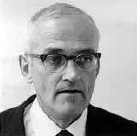Clair Patterson
| Clair Cameron Patterson | |
|---|---|

Clair Cameron Patterson
|
|
| Born | June 2, 1922 Mitchellville, Iowa, U.S. |
| Died | December 5, 1995 (aged 73) Sea Ranch, California, U.S. |
| Nationality | United States |
| Alma mater | |
| Known for | uranium–lead dating, age of the Earth, lead contamination |
| Awards |
Tyler Prize (1995) V. M. Goldschmidt Award (1980) J. Lawrence Smith Medal (1973) |
| Scientific career | |
| Fields | geochemistry |
| Institutions | California Institute of Technology |
| Thesis | The Isotopic Composition of Trace Quantities of Lead and Calcium (1951) |
| Doctoral advisor | Harrison Brown |
Clair Cameron Patterson (June 2, 1922 – December 5, 1995) was an American geochemist. Born in Mitchellville, Iowa, Patterson graduated from Grinnell College. He later received his Ph.D. from the University of Chicago and spent his entire professional career at the California Institute of Technology (Caltech).
In collaboration with George Tilton, Patterson developed the uranium–lead dating method into lead–lead dating. By using lead isotopic data from the Canyon Diablo meteorite, he calculated an age for the Earth of 4.55 billion years, which was a figure far more accurate than those that existed at the time, and one that has remained largely unchanged since 1956.
Patterson had first encountered lead contamination in the late 1940s as a graduate student at the University of Chicago. His work on this subject led to a total re-evaluation of the growth in industrial lead concentrations in the atmosphere and the human body, and his subsequent campaigning was seminal in the banning of tetraethyllead in gasoline and lead solder in food cans.
Clair (Pat) Patterson was born in Mitchellville, Iowa. He graduated from Grinnell College with a degree in chemistry. There, he met his future wife, Lorna (Laurie) McCleary. For graduate school, they both attended the University of Iowa, where he was awarded an M.A. in molecular spectroscopy. Both were then sent to work on the Manhattan Project, first at the University of Chicago and then at Oak Ridge, Tennessee, where he encountered mass spectrometry.
...
Wikipedia
